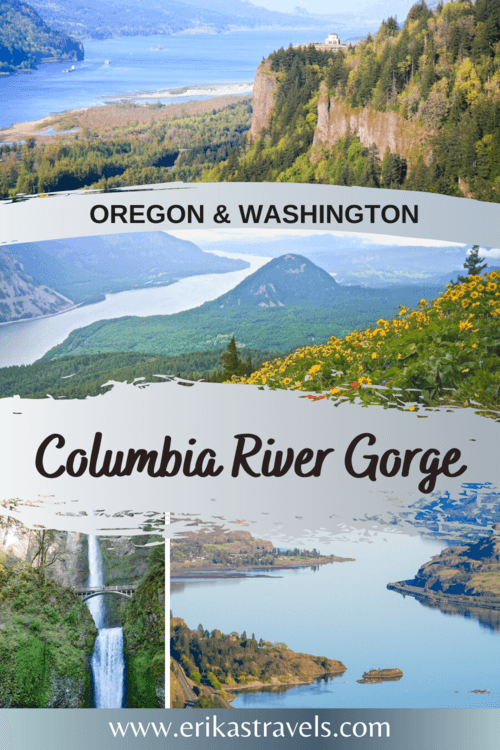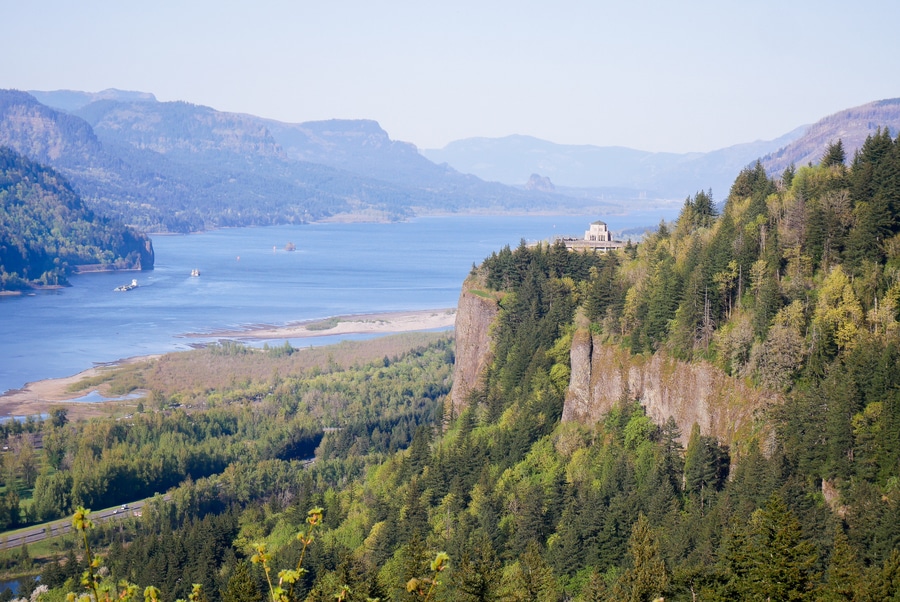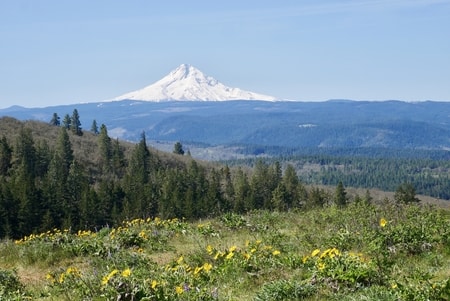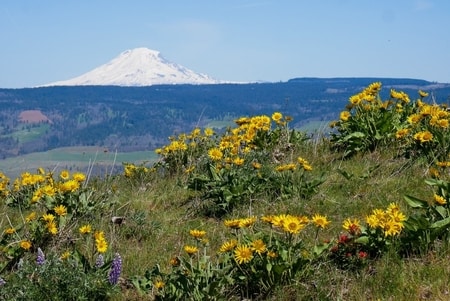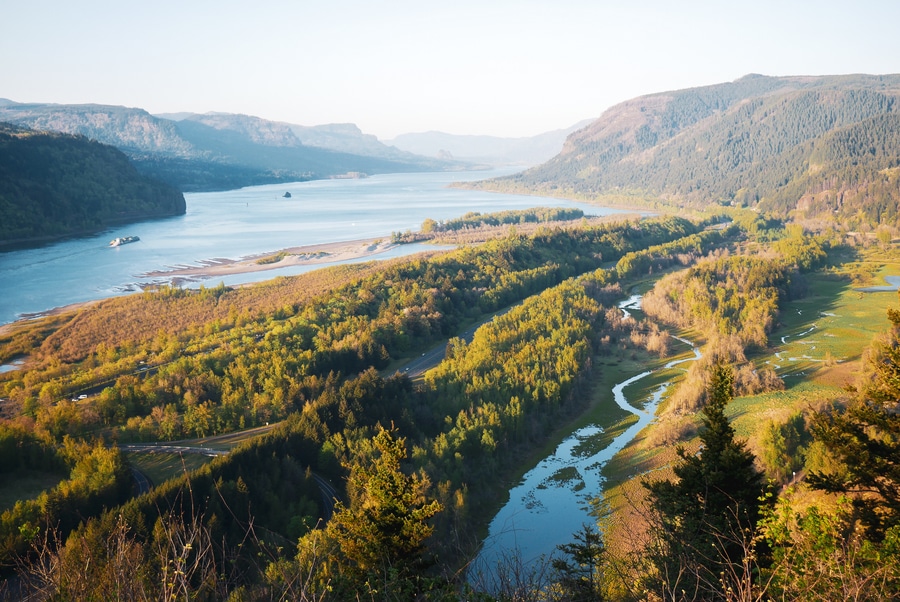
The Best Columbia River Gorge Hikes and Viewpoints
The Columbia River Gorge divides Oregon and Washington in spectacular fashion. A national scenic area and magnet for recreation enthusiasts, it encapsulates much of what makes the Pacific Northwest so special. The gorge is a microcosm of many of the region’s most alluring features—showcasing verdant wonderlands, arid plateaus, and one of the mightiest waterways in the United States.
The outdoor wonderland attracts hikers, kiteboarders and windsurfers from around the world. Its hiking trails feature fern-lined canyons, gushing waterfalls, wildflower-strewn fields, and grand vistas of snow-capped peaks.
With its plethora of vistas and diverse topography, the national scenic area certainly puts the ‘gorge‘ in gorgeous (sorry, I had to).
THE COLUMBIA GORGE NATIONAL SCENIC AREA
The mighty Columbia River begins in the mountains of British Columbia and empties out into the ocean near Astoria. Along the way, it grows larger and larger as it collects tributaries. By the time the Columbia reaches the shores of the Oregon Coast, it appears as grand as the ocean itself. I’m always struck by the river’s sheer magnitude.
From 1980 to 1986, the Columbia Gorge became the second National Scenic Area in the United States. The scenic area consists of 293,000 acres that spread out across six counties in Oregon and Washington.
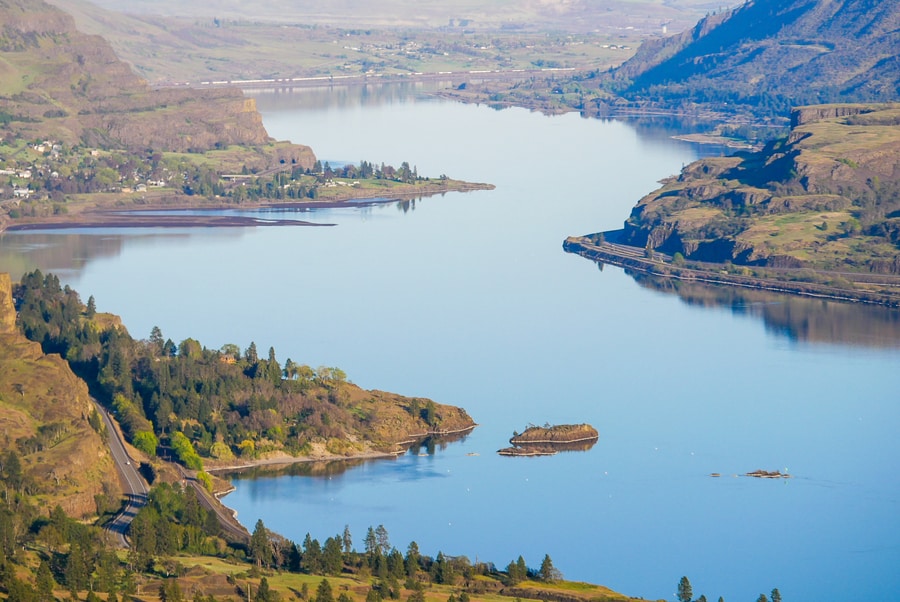
The Columbia Gorge is steeped in history. It has acted as a transportation corridor for thousands of years—first for Native American populations and later for Lewis and Clark as they journeyed west.
Today, it still remains one of the most efficient corridors for travel across the Cascade Mountains.
THE COLUMBIA GORGE IN OREGON
Though the Columbia River Gorge boasts numerous attractions in both Oregon and Washington, its southern banks contain all but a few of the area’s most noteworthy destinations. The stretch between Troutdale and The Dalles boast’s the gorge’s best waterfalls, its most renowned scenic viewpoints, and its most charming population centers.
Interstate 84 travels along the southern banks of the Columbia River, connecting Portland with Salt Lake City. It parallels the historic Columbia River Highway and acts as the most convenient transportation route along the gorge.
THE HISTORIC COLUMBIA RIVER HIGHWAY
The Historic Columbia River Highway is a 75-mile-long scenic road that connects Troutdale with The Dalles. Built between 1913 and 1922, it was the first planned scenic roadway in the United States. Its design intended to take advantage of the many waterfalls and vistas in the area.
For its scenery and engineering feat, the Historic Columbia Highway has been recognized in numerous ways. It is included in the National Register of Historic Places, designated as a National Historic Civil Engineering Landmark, and considered a “destination unto itself” as an All-American Road.
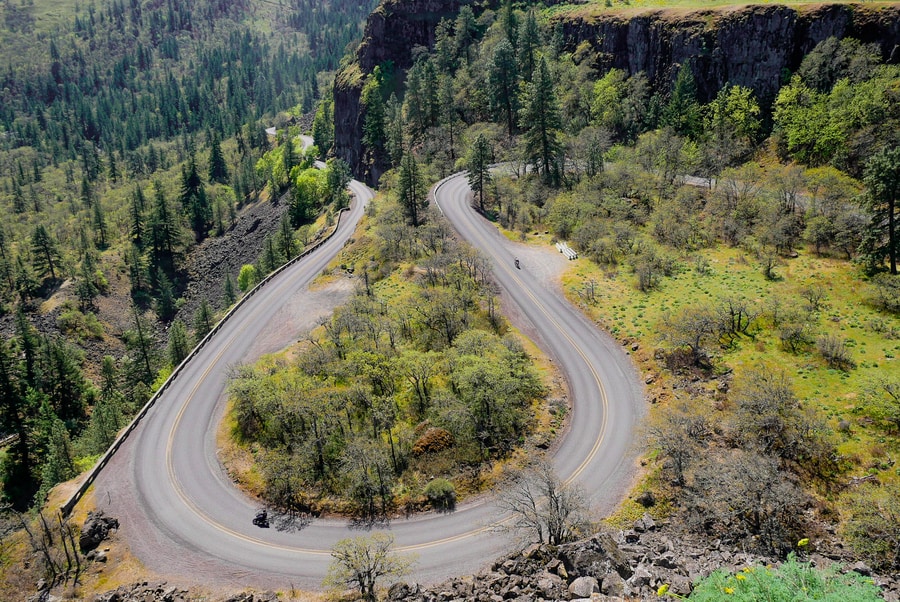
Prior to the construction of Interstate 84, the Old Columbia River Highway was the main transportation link between Portland and the desert.
The Highway was left partially intact after the construction of I-84. Some of its sections, however, remain cut into pieces or partially destroyed. Efforts are currently underway to create vehicle-free paths for cyclists and pedestrians—transforming its abandoned sections into a recreational trail.
THE VISTA HOUSE
The Vista House sits on a rocky promontory, 693 ft above the Columbia River. It is a popular rest stop along the Crown Point State Scenic Corridor.
The Columbia Gorge Vista House opened in 1918 as a glamorous rest stop and observatory. The structure features marble floors, stained glass windows, an a stunning view. In the words of The Oregonian, it was “the finishing achievement for the greatest highway in America.”
Each year, millions of visitors bypass the Historic Columbia Highway en-route to Multnomah Falls. They zoom down I-84, zipping right below the famous building and entirely skipping a spectacular stretch of road.
The first few times Dan and I visited the gorge, we did the same—not knowing that the Vista House and Portland Women’s Forum Scenic Viewpoint afford some of the area’s most rewarding pit-stops.
COLUMBIA GORGE WATERFALLS
Oregon is known for its epic waterfalls. Thundering cascades can be found throughout the western half of the state. They are the crown jewels of places like Silver Falls State Park and the McKenzie River Highway.
The Columbia Gorge has an unusually high waterfall density. It contains more cascades per square mile than any other place in the country.
The Oregon side of the river houses a vast majority of the gorge’s waterfalls (77 to be exact). Some contain paved pathways and are easily accessible from the highway. Others require a bit of a hike.
-
LATOURELL FALLS
Latourell Falls is the closest major waterfall to the city of Portland. While many skip it and head straight to Multnomah, the 249 ft ribbon of water is a Columbia Gorge must-see.
The cliff behind Latourell Falls is notable for its lime-green lichen and vertical basalt columns. Aesthetically, the vibrant colors and vertical columns add intricacy to the cascade’s surroundings.
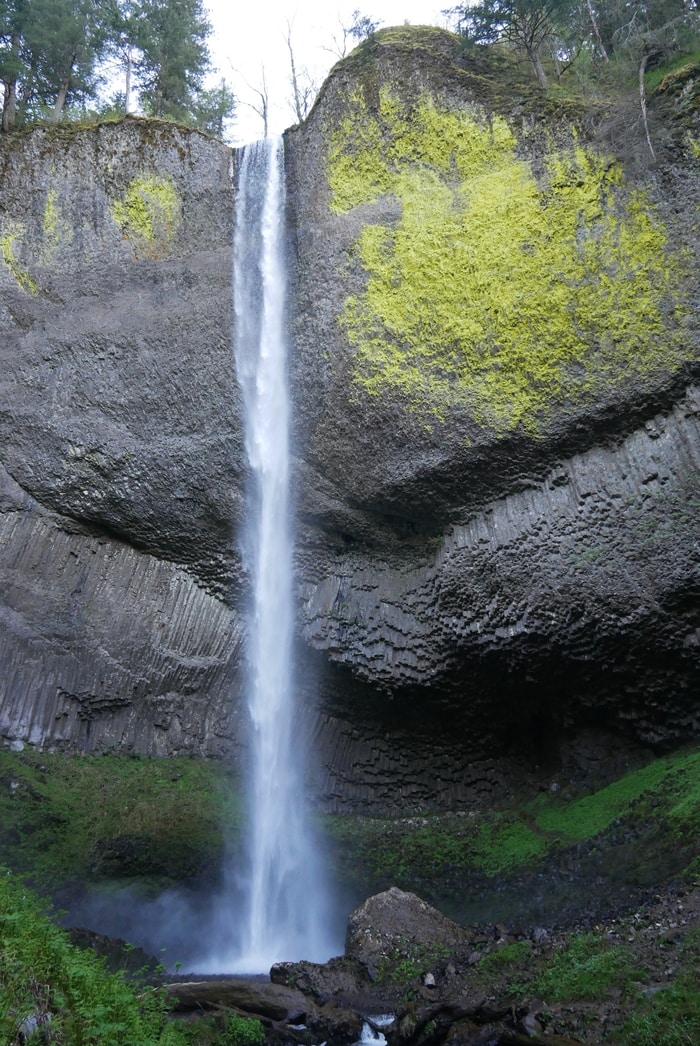
The beautiful 225-foot single drop waterfall is easily accessible from the Historic Columbia River Highway.
From the parking area, a 2.3 mile loop passes by the waterfall and leads to a second 134 ft cascade.
-
BRIDAL VEIL FALLS
Bridal Veil Falls is the second major cascade along the Historic Columbia Highway. Its parking area leads to two short hikes: one showcasing the beautiful waterfall and the other revealing views of the Columbia River.
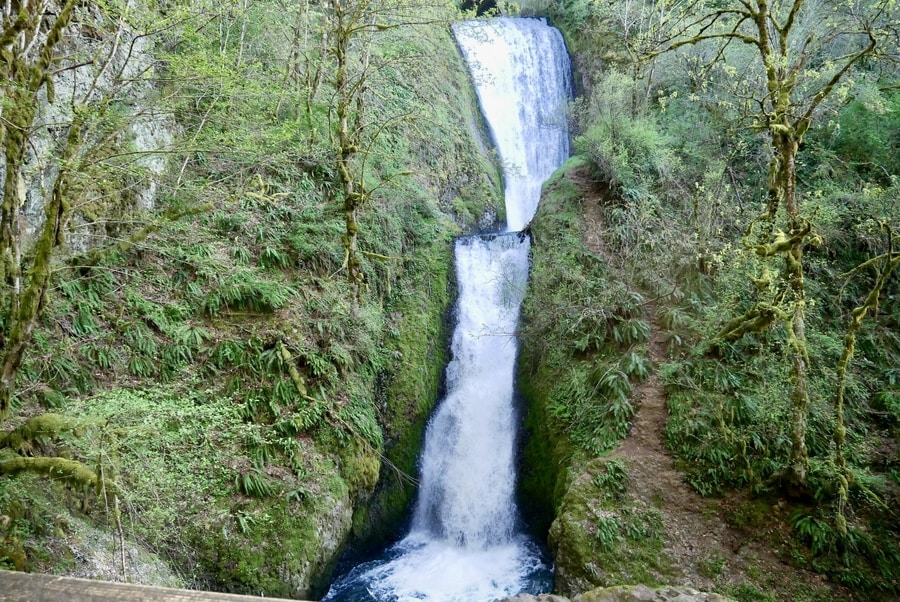
The lower trail descends 0.3-miles to the base of the picturesque cascade. The waterfall ducks under a historic 1914 bridge and spills over mossy basalt in two tiers. Together, the two drops total 120 ft.
-
MULTNOMAH FALLS
Photogenic Multnomah is Oregon’s most beautiful waterfall and one of the most recognizable cascades in the United States. Dropping 620 spectacular feet, it is the tallest of the Columbia River Gorge’s many waterfalls. It is also close to Portland and just off Interstate-84, making it one of Oregon’s most oft-photographed natural wonders.
Each year, it attracts more than 2 million sightseers.
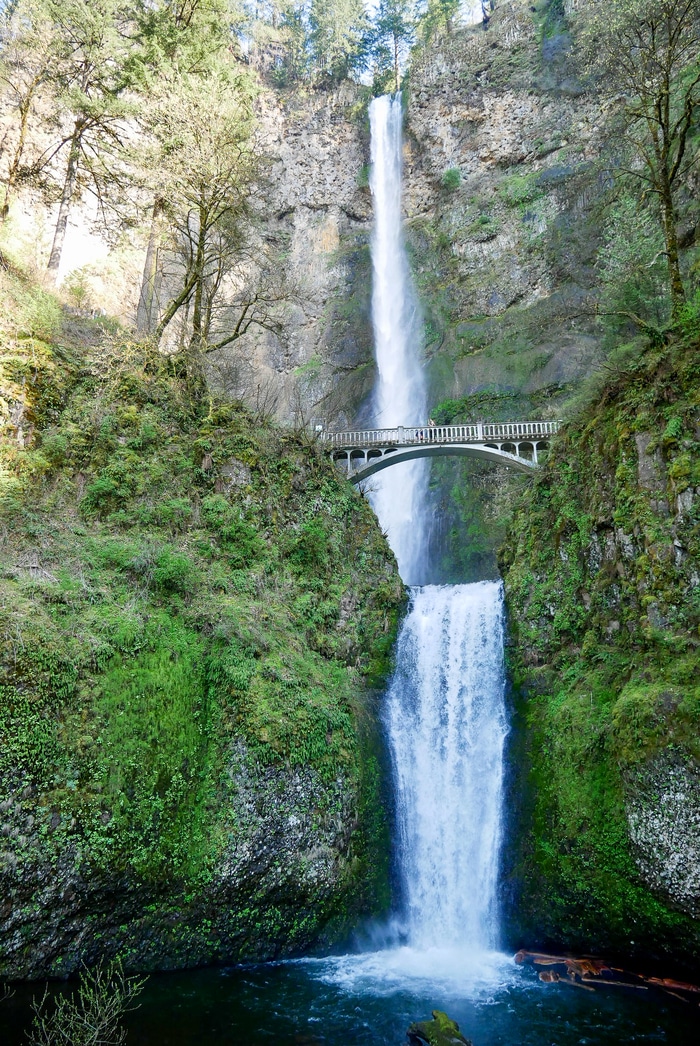
While there is no denying the beauty of Multnomah Falls, the attraction’s easy access and widespread renown means huge tourist throngs are inevitable.
As soon as you set eyes on the waterfall’s spectacular silver ribbon, however, you’ll understand why Multnomah is the area’s centerpiece and crown jewel.
-
WAHKEENA FALLS
Wahkeena Falls may not be as tall as Latourell and Multnomah, but the twisting waterfall is nonetheless among the gorge’s most striking.
At the time of our visit, the Wahkeena Falls parking area remained closed off to visitors. However, we were still able to access the waterfall from the Multnomah Falls Parking Area. In order to visit the cascade, we had two options. The first consisted of walking along the Old Columbia Highway for about one mile round-trip. The other required a five mile trek that also included Fairy Falls.
Due to lack of time, we only did the out-and-back hike.
But the 5-mile trek is at the top of our future gorge to-do list.
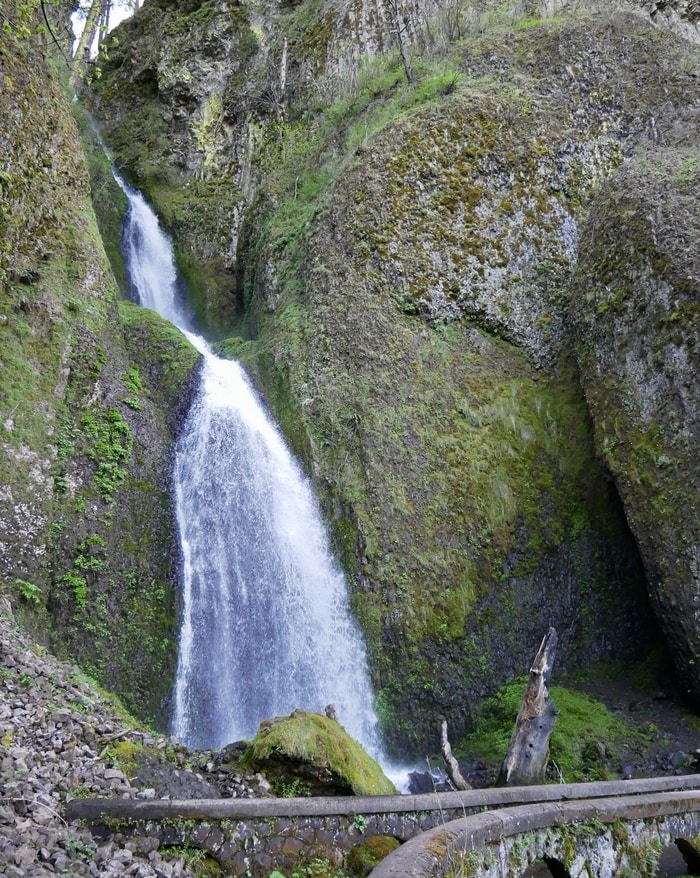
Despite the fact that Wahkeena Falls lies within close proximity of Oregon’s most notable cascade, Dan and I were able to enjoy the thundering water in complete solitude.
It was a refreshing contrast to the congestion at nearby Multnomah.
-
WAHCLELLA FALLS
Two-tiered Wahclella tumbles over moss-clad rocks into a picturesque plunge pool. The waterfall consists of upper and lower segments that have a combined height of 350 ft. The longer upper section is not completely visible, while the thundering lower segment stands 60 ft.
The Wahclella Falls Trailhead is located directly across the highway from the Bonneville Dam. It is the easternmost ribbon of water in a long string of stunning cascades.
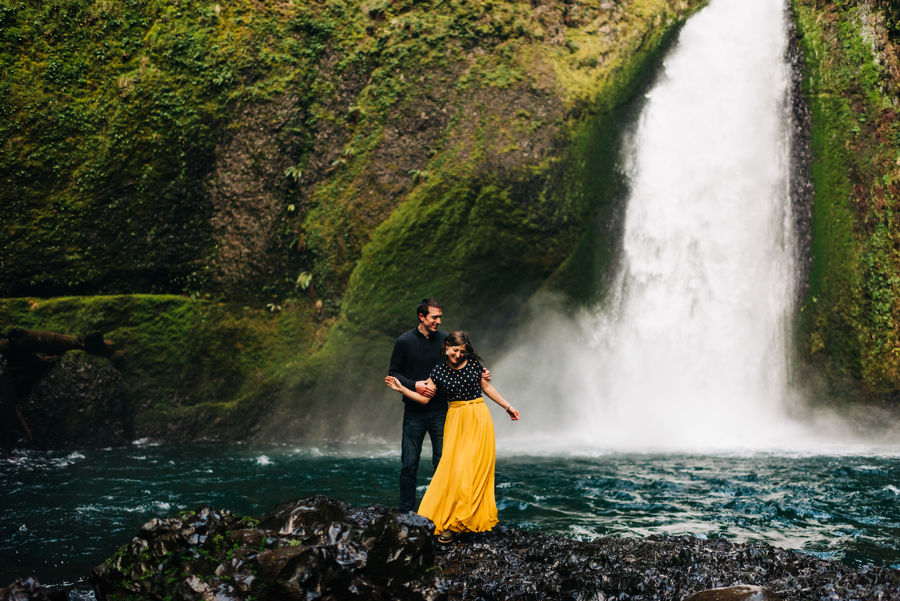
Due to its picturesque nature, Dan and I even chose Wahclella Falls as the site of our engagement photos!
ONEONTA GORGE (CURRENTLY CLOSED)
The Oneonta Gorge is a narrow moss-covered canyon located within the larger Columbia River Gorge National Scenic Area. It is one of the most beautiful spots in Oregon.
A narrow waterfall lies at the end of the moss-covered emerald canyon. Reaching Lower Oneonta Falls requires wading in an icy river that cuts through the area’s verdant canyon walls.
It is a short hike that packs in a huge reward.
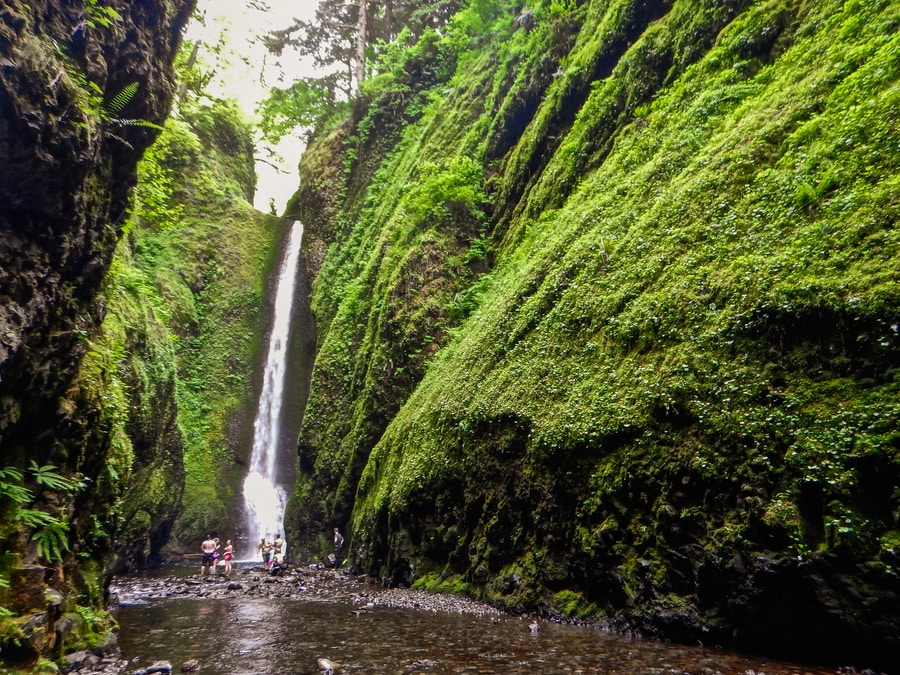
Unfortunately, the canyon remains closed off to visitors as a result of the 2017 Eagle Creek Fire. Dan and I count ourselves incredibly lucky to have visited the place merely months before flames turned the area into a hazard zone.
Currently, the Oneonta Gorge does not have a set reopening date.
HOOD RIVER
Hood River lures both locals and tourists with its craft breweries, quaint downtown, and beautiful setting. Like a mini version of Bend Oregon, the town centers almost entirely around its outdoor offerings. It is a launchpad for adventures in the Mount Hood National Forest, excursions through the Hood River Fruit Loop, and recreation along the Columbia.
In the 1960s, the Columbia River’s white-capped waters and constant wind put Hood River on the national windsurfing radar. Today, the town is world-renowned as one of the world’s best destinations for kiteboarders and windsurfers.
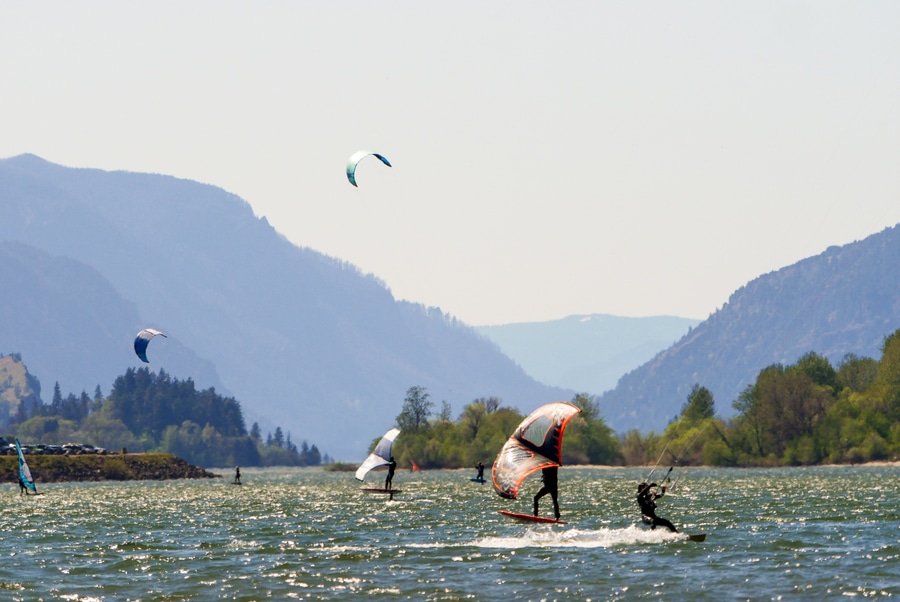
A sandy spit juts out into the water and forms a natural dock that attracts swimmers and water sports enthusiasts in droves. At nearly half a mile long, the sand bar and its shallow waters are the perfect place to cool down on a hot sunny day.
Though Dan and I have never been kiteboarding, we could have spent all day watching the athletes as they glided about the choppy waters.
It looked like so much fun that we vowed to take kiteboarding lessons on our next visit to the area.
ROWENA CREST AND TOM MCCALL PRESERVE
Visiting Rowena Crest is among the top things to do along the Columbia River Gorge.
Located between Hood River and The Dalles, the roadside viewpoint offers some of the area’s most epic vistas. Many visit Rowena Crest for its iconic views of the Historic Columbia River Highway’s horseshoe bend. Thanks to Instagram, the U-shaped curve in the road is one of the most well-known Columbia Gorge attractions.
In addition to providing a unique view of the Historic Columbia Highway, Rowena Crest features sweeping panoramas of the vast river, arid cliffs, and wildflower-splashed hillsides.
The Rowena Crest Viewpoint marks the starting point of a spectacular hike through the Tom McCall Preserve.
The short 3.4 mile trail meanders up a grassy slope that explodes with vibrant wildflowers in the spring. From its summit, the views of Mount Hood and Mount Adams are breathtaking.
THE COLUMBIA GORGE IN WASHINGTON
Washington’s side of the Columbia River Gorge receives far less attention than its Oregon counterpart. The area’s hikes and viewpoints, however, are likewise spectacular.
The Washington portion of the Columbia Gorge National Recreation Area extends from Camas to Maryhill. Scenic Highway 14 traces the riverbank and provides access to many of the area’s best hiking areas, wildflower meadows, and scenic viewpoints.
CAPE HORN
Cape Horn overlooks the Columbia River’s sparkling blue waters and cavernous gorge. It is the first major viewpoint along Washington’s Highway 14.
A 7.5 mile scenic loop descends from the viewpoint to the river’s edge. It passes by lava rocks and basalt towers.
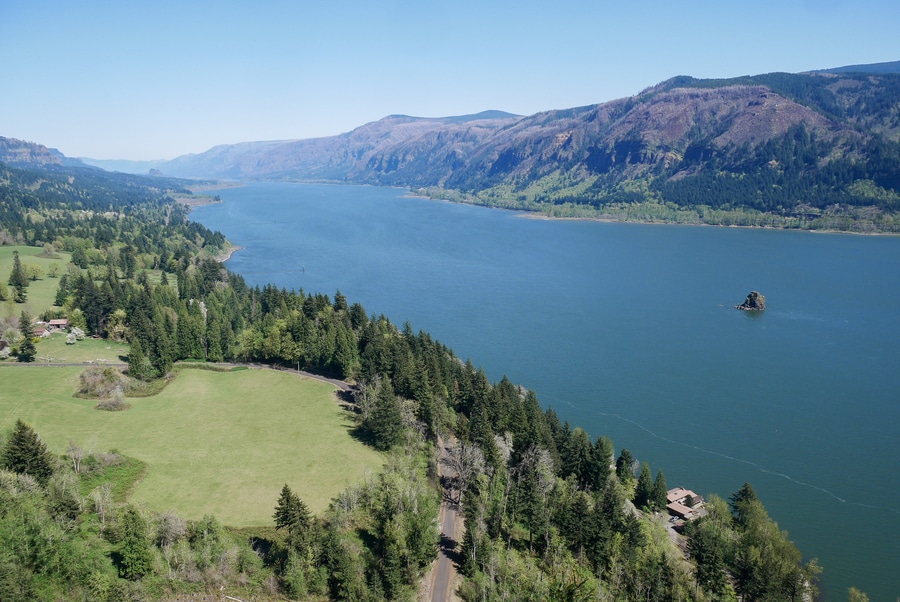
Nesting peregrine falcons reside in the basalt cliffs below Cape Horn.
As a result, the trail is only accessible to tourists between July 16th and January 31st.
BEACON ROCK
One of the Columbia Gorge’s most distinguishable features, beacon rock looms over the river. It can be spotted from a number of the area’s scenic viewpoints.
The 848-foot basalt landmark was once the core of a volcano. When Ice Age floods swept out large chunks of land, the volcano’s inner core was all that remained. Beacon Rock is among the tallest monoliths in North America.
![]()
A steep pathway leads to the top of the rock outcrop and culminates in epic views of the river. The three-quarter mile out-and-back trail dates back to 1918. It contains handrails, bridges, and 51 switchbacks.
Though crowded, the 1.5 mile Beacon Rock Trail is among the most memorable Columbia River Gorge hikes.
DOG MOUNTAIN
Dog Mountain is a legendary destination within the Columbia River National Scenic Area. This Washington gem offers stunning views of the gorge and its verdant hillsides. On clear days, it showcases Mount Hood and Mount St Helens.
The challenging 6 mile hike ascends 2,900 ft above the gorge. In late spring and early summer, it boasts some of the best wildflower displays in the Pacific Northwest.
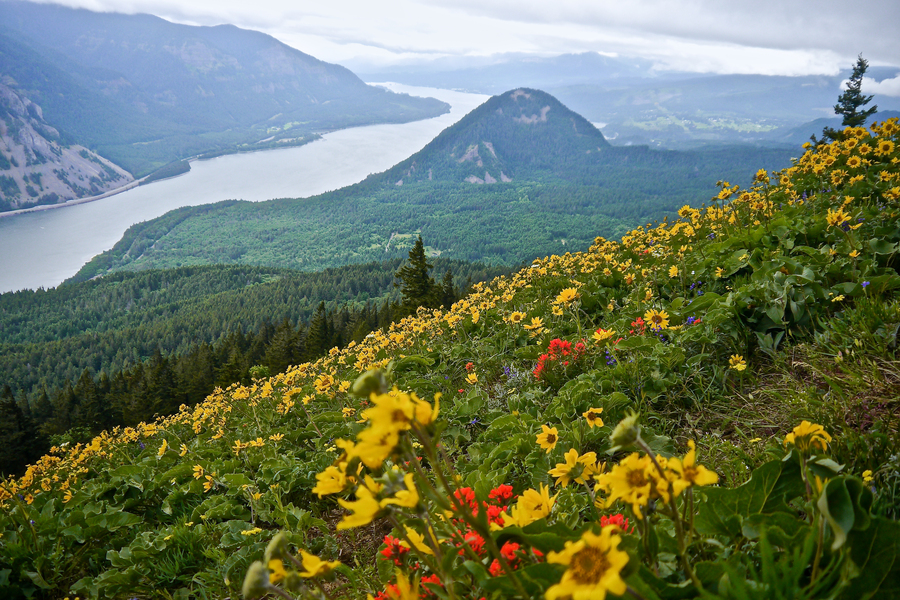
Note that, in addition to the existing $5 day use fee, a new permit system is in effect for weekends between March 31 and July 1.
BONNEVILLE DAM
The Bonneville Dam spans the entire length of the Columbia Gorge and is accessible from both Oregon and Washington. It has two visitor centers and offers free tourist admission.
The dam was built and is managed by the United States Army Corps of Engineers. At the time of its construction in the 1930s, it was the largest water impoundment project of its type in the nation. The dam produces 5 billion kilowatts of electricity each year, which is enough to power 80% of the Pacific Northwest.
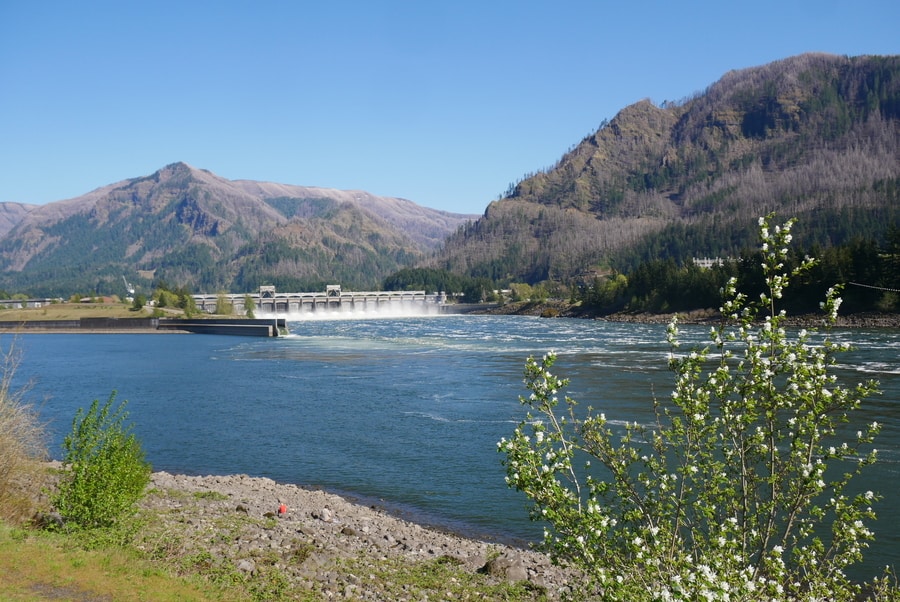
The largest fish hatchery in Oregon, called the Bonneville Fish Hatchery, is located next to the dam.
CATHERINE CREEK
Since Dan and I had already hiked Dog Mountain on a previous visit to the Columbia River Gorge, we chose a different wildflower trail on our most recent foray into the area.
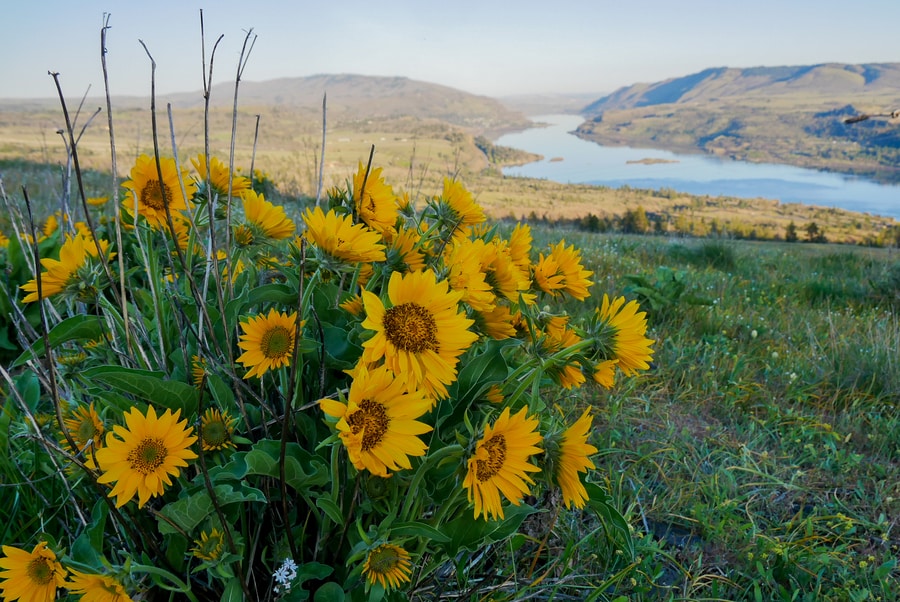
Catherine Creek is well-known as one of the most beautiful hiking destinations along Washington’s side of the gorge. It features a series of trails that wind through forest and along hillsides. Its trails provide beautiful views of Mount Hood and the river.
And best of all, the area contains only a fraction of the crowds that can be found on Dog Mountain.
THE MARYHILL STONEHENGE
Dan and I haven’t actually made it as far as the Maryhill Stonehenge, but the monument is no doubt one of the top attractions along the Washington side of the riverbank.
The memorial is a replica of Stonehenge in England. It was commissioned in the early 20th century by a wealthy entrepreneur, and dedicated on 4 July 1918 as a memorial to victims of World War I.
COLUMBIA RIVER GORGE ACCOMMODATIONS
While many tourists choose to visit the Columbia River Gorge as a day trip from Portland, the area’s plethora of attractions merit at least two days of exploration.
Luckily, there are plenty of wonderful places to stay on both sides of the river.
On the Washington side, the Skamania Lodge and Spa is a popular choice. It is situated on 176 scenic acres along the River. RubyJune Inn in White Salmon, too, receives great reviews.
On the Oregon side, Hood River hosts a bulk of the accommodations. The Columbia Cliffs Villas, the Hood River Hotel and the Carson Ridge Luxury Cabins are highly ranked choices.
BEST TIME TO VISIT THE COLUMBIA GORGE
With waterfalls, wildflowers, and scenic views, the Columbia River Gorge is a fantastic place to visit year-round. In late spring, wildflowers paint the hillsides, while iconic Pacific Northwest Peaks wear a thick cape of snow. It is the most beautiful time to visit the gorge, provided that the sun is shining.
But while the colors fade a bit in late summer and fall, the warmer months remain a fantastic time to visit the area.
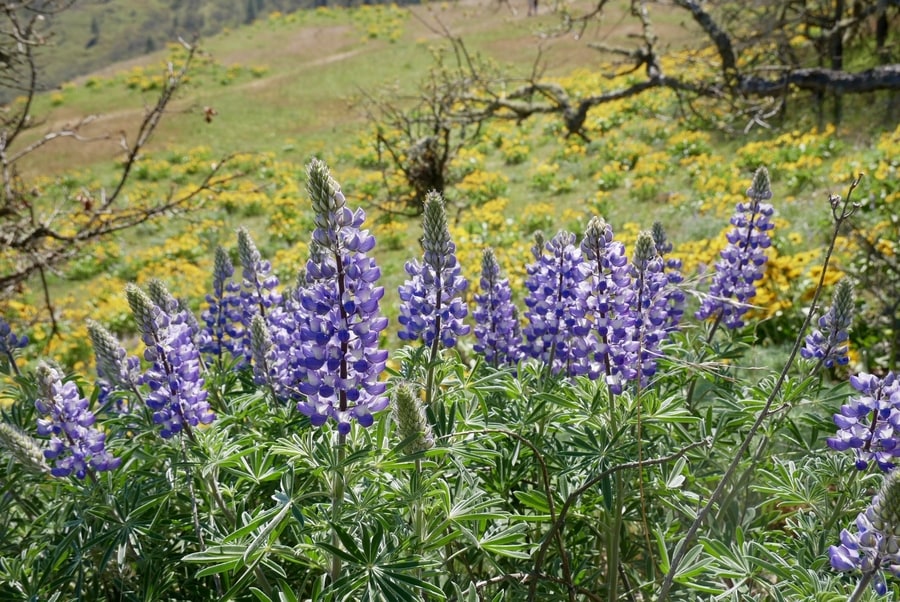
In winter, most hiking trails and viewpoints remain accessible, while thinning crowds provide an opportunity to enjoy the area’s attractions in relative solitude.
*****
As the Columbia River makes its way toward the sea, its surrounding scenery unfolds in spectacular fashion. The behemoth river—once a conduit for travel over the Cascades—has now become a destination of its own. The river draws year-round recreation enthusiasts with its varied scenery and unforgettable hikes.
From arid plateaus to misty waterfalls and from snow-clad mountains to fern-laden canyons, the Columbia River National Recreation Area is nothing short of gorgeous.
Did You Enjoy this Guide to the Columbia River Gorge? Pin It!
